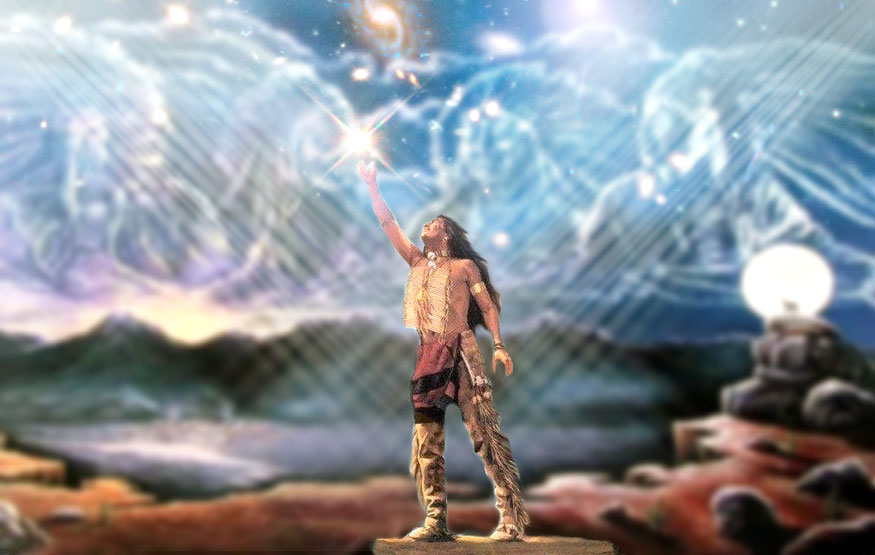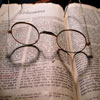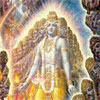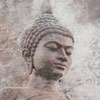Reincarnation And The American Indian
 by Manly P. Hall
by Manly P. Hall
In matters of philosophy and faith the American Indian is by nature an individualist. His convictions are influenced profoundly by his interpretation of the experiences of daily life, and by the visions and other mystical extensions of consciousness resulting from vigil, fasting, prayer, and meditation. Members of the same tribe may differ widely in their beliefs. Religious tolerance is general, and nonconformity brings no reproach if a man practices his beliefs with sincerity. Therefore, when an ethnologist asks some old sachem or an outstanding tribal citizen for a summary of the religion of his people, the learned elder, as likely as not, will elucidate his personal opinions of the subject. Thus many differing accounts may be secured from a single group. Due to this complication, all broad statements covering Indian theology are subject to a variety of exceptions.
In his North American Mythology Dr. Hartley B. Alexander makes a cautious generalization of the Indian attitude toward the doctrine of successive lives: “Belief in the possibility of rebirth is general,” he writes, “although some tribes believe that only young children may be reincarnated, and certain of the Californians who practice cremation bury the bodies of children that they may the more easily be reborn.” Referring to Arctic tribes, the same author notes: “Birth and death, in Eskimo conception, are less a beginning and an end than episodes in life . . . Souls may be born and reborn both as man and as beast, and some have been known to run the whole gamut of the animal kingdom before returning to human shape. Ordinary human souls are reborn as men.”
Some Indian nations have reincarnation or transmigration as an essential tenet of tribal doctrine, while others have only vestiges of the concept. Certain Greenland tribes, for example, believe that the soul of a dead relative will enter the body of a newborn babe, guarding and instructing the child until it reaches maturity, when its own soul takes control. Several tribes hold that scalping prevents rebirth, as the spiritual nature is connected with certain locks of hair.
The Indians of Eastern United States are convinced that the after-death world of the red man is exclusively for the use of their own race–the white man has a different heaven. Because of their admiration for George Washington, these Indians say that he has a special house just outside the door of the Indian Spirit Land. Medicine priests who have left their bodies and journeyed along the path of souls report that the Great White Father is having a splendid time in his fine home.
The Cherokee recognized no essential difference between the spirits of human beings and those of animals. All the kingdoms of nature shared a common immortality. Although the animal belonged to a lower order of intelligence than man, and its body might properly be used for food, the spiritual principle which animated the brute form was indestructible. It was necessary to kill animals that men might live, but these four-footed younger brothers had their place in the afterlife. The hunter did not actually kill the animal, he only deprived it of a body for a short time. The Indian never hunted for sport, and when he killed the body of a deer or other wild creature, he offered prayers to its spirit, and honored its memory with sacred rites and ceremonies. In his Myths of the Cherokee James Mooney explains the philosophy of these Indians as it relates to this interesting subject. The hunter is pardoned “through a peculiar doctrine of reincarnation, according to which, as explained by the shamans, there is assigned to every animal a definite life term which cannot be curtailed by violent means. If it is killed before the expiration of the allotted time the death is only temporary and the body is immediately resurrected in its proper shape from the blood drops, and the animal continues its existence until the end of the predestined period, when the body is finally dissolved and the liberated spirit goes to join its kindred shades in the Darkening Land.”
The numerous tribes of the Sioux Nation inclined toward a belief in rebirth. Of this group James Owen Dorsey writes: “Some of these metempsychosists go so far as to aver the that they have distinct recollections of a former state of existence and of the passage into this.” In another place he adds: “They believe in the transmigration of souls. Some of the medicine men profess to tell of what occurred to them in bodies previously inhabited, for at least six generations back.”
Most authors do not distinguish clearly between reincarnation and transmigration, thus further clouding an already obscure field of research. Enough can be gathered, however, to prevent misunderstanding. A clearly defined trend is noticeable, which would indicate that the belief in rebirth is more prevalent among certain classes of Indians than among particular tribes. It is most likely to be found among the shamans, priests, prophets, medicine men and seers. These mystics have examined into the spiritual mysteries of life, and like the Yogis of India claim to possess faculties and powers by which they can explore into the secret workings of nature. They accompany souls into the shadow-life, wander about on the borderland which divides the living from the dead, and can see the life principles entering and leaving the physical body.
Occasionally those not consecrated to the holy life may enjoy visions or mystical experiences. As among the ancient Greeks, there are numerous accounts of warriors who seemingly have died, and after a time returned to life. The words of such men have great authority, and the reports which they bring back of their adventures while out of the body become part of the tribal tradition. It is not unusual for these resurrected ones to turn from their ordinary pursuits and take on the duties of priests and spiritual advisers. Most Indian religious cults, like that of the Ghost Shirts, begin with prophets who have returned from the dead.
In The Soul of the Indian, Charles Alexander Eastman (Ohiyesa) a member of the Sioux Nation, who wrote extensively on Indian culture, refers to reincarnation thus: “Many of the Indians believed that one may be born more than once, and there were some who claimed to have full knowledge of a former incarnation.” Such recollections of previous existences nearly always resulted from mystic practices or other unusual circumstances. One famous medicine man gained his powers after being struck by lightning.
Some years ago Dr. Paul Radin carried on extensive researches among the members of the Winnebago Tribe of Wisconsin. He found that “By the belief in reincarnation the Winnebago entirely bridge the gulf between life and death . . . To live again is the greatest desire of the Winnebago, and practically every secret society holds this out as the lure to the outsider. If you join the Medicine Lodge you will become reincarnated, they say, and the other ritualistic organizations make the same claim. But not only by joining an organization is it possible to be reincarnated; if you live an upright life, if you die on the battlefield, reincarnation also awaits you.”
Dr. Radin was fortunate enough to secure directly from a Winnebago shaman an account of three of this wise man’s previous lives. The shaman who is identified by the initials T. C. said that he had been killed, while still a lad, by a hostile war party. He did not know that he was dead until he found his own body among the slain. He was then taken to the Spirit Land where he lived with an old couple until the desire to be reborn came over him. The Chief of the Spirit Village told him that he could go back to earth and obtain revenge on the tribe that had killed his relatives and himself. He was taken into what seemed to be a room, where he could hear little children playing outside. He wanted to join them, so he went through a door. There was a rush of cold air, and he began to cry, and he knew that he was being born from a woman’s body.
In that life T. C. grew up to be a great warrior, and he slew many men and revenged himself upon his enemies. He died of old age, and left his body without pain. He even watched the people as they buried his remains. He had much pleasure in the afterlife, and even talked face to face with Earthmaker. There were spirits about, and he was like them.
After a time T. C. again returned to the physical world and it was in this latest incarnation that he told his story to Dr. Radin, remarking, “I am going through the same that I knew before.”
The Peyote cult has many followers among the Winnebago. They eat the peyote or make a liquid from it which they drink. The mescal, or peyote, is a small cactus, used medicinally as a stimulant and antispasmodic. With the Indians the effect is to produce visions and a temporary clairvoyance, and the plant is also believed to have great curative powers. The Peyote cult denies the doctrine of reincarnation, and this has caused ill feeling between the old tribal shamans and the new cult. Those Winnebago who will have nothing to do with the Peyote people claim that the use of the plant destroys the spirit, and the addicts will not be reborn again but will die utterly.
It is fortunate, indeed, that Dr. Radin has been able to continue his researches into the mystical philosophy of the Winnebago. In 1945 he published the sacred ritual drama of these Indians under the title, The Road of Life and Death. Making use of the old belief in reincarnation, the medicine priests interpreted life as a mystical road to the heaven worlds and back again ad infinitum. In his new book Dr. Radin tells us that the initials T.C. stand for the venerable Thunder-Cloud. Not only did this wise man remember his past lives; he recalled also his previous initiation into the secret rites of the Spirit-Road.
In the ritual, Earthmaker, the Great Spirit, promised that if the ceremonies of the rites were properly performed the initiate would have more than one life. Earthmaker said, “I will always keep the door through which he may return to earth open to him. When he becomes reincarnated he can live wherever he wishes. He can return to the earth as a human being or he can join one of the various bands of spirits, or, again, if he wants to, he can become one of the beings who live under the earth.”
Dr. Radin sums up the psychological aspect of the doctrine of rebirth as held by the Winnebago thus: “With the belief in reincarnation, the priest-thinker could do much more. Here a kind of continuum already existed. The priest-thinker had merely to develop the concept of a continuing consciousness. Thus the first attribute of divinity, permanence, was on its way to accomplishment. This permanence was further enhanced and fixed by having an individual born again into the same family and reliving, in every detail, his previous existence.”
The Winnebago were led to the belief in the plurality of lives by the pressure of adversity and affliction. They were in much the same position as the white man of today. The only escape from war, crime, sorrow, and misery was through the strengthening of the internal spiritual self. Man must have a philosophy of living that explains the obvious tragedy of the world and at the same time proves that the human being can live well and attain security by a high standard of personal conduct. All mature civilizations are confronted with this problem of universal ethics.
In his delightful book, What the White Race May Learn From the Indian, George Wharton James summarizes the Amerindic philosophy of death. “The Indian,” he writes, “believes in immortality without any admixture of complex theological ideas. His is a simple faith which he accepts as he accepts life. He believes that when he dies his spirit goes to its new life just as at birth he came into this life . . . When death approaches he faces it with calmness, equanimity and serenity . . . Those who are left behind may wail for their loss, but the one who departs asks for and receives no sympathy.”
In matters of spiritual conviction the Indian was by nature a silent man. He held his mystical beliefs close to himself and the members of his tribe. He had no instinct to convert others; to him each man must find his own Spirit-Path, and having found his way must live it gloriously and courageously to the end. After contact with the Europeans, the Indian became even more reticent on the subject of religion. The white man was always trying to force his beliefs upon the Amerinds, condemning all faiths but his own, but applying to himself very little religion of any kind. Because of these critical attitudes the European closed in his own face the sanctuaries of the American Indian esoteric tradition. As a result, very few Anglo-Saxons have any conception of the more profound aspects of the red man’s mystical theology, occult philosophies, and disciplines.
As the Amerindic nations had no written languages it is not possible to restore this ancient learning from the crude pictographs which are the only literary remains of the old times. The lore of the tribes survives only in the memory of the old men and the medicine priests. If these shamans are silenced by the white man’s criticism and contempt, the wisdom of the tribes dies with them and is lost beyond all hope of recovery. This has already happened in a number of cases and, sad to relate, even those ethnologists and anthropologists who have devoted the best years of their lives to research among the surviving tribes are seldom interested in Amerindian metaphysics. Vestiges of a belief in reincarnation are to be found throughout the North American tribes, but only the initiates of the various mystical societies have a complete understanding of the doctrine. Under these conditions a complete statement is impossible at this time.
Dr. S. Baring-Gould explains the principle of rebirth as it was held by early peoples. Although his statement is general it applies accurately to the speculations of the Indians of North America. “The human soul,” he observes, “with its consciousness of infinity, seemed to be something already perfected in a pre-existing state, something which had gone through a succession of phases of existence, and which would undergo a further succession. In the dream of metempsychosis we may trace the yearnings and gropings of the soul after the source whence it derived its consciousness, counting its dreams and hallucinations as gleams of memory, reflecting acts which had taken place in a former state of being. After death, the translation of the soul was supposed to continue.”
So complete was the destruction of the religions, philosophies, and historical records of the Indians of Central America by the Spanish, that the mystical tradition among these nations appears to be hopelessly lost to modern scholars. There are hints, however, such as the casual observation of Bernard Picart in his Religious Ceremonials. In summing up the metaphysics of the Incas of Peru this learned Frenchman writes: “They believed that all who were born in a material world would live again in a material world.”
Although no scriptural writings of the Mayas or Aztecs have been decoded, and it is impossible therefore to quote an authoritative text, it is almost certain that they believed in rebirth. No nation of the ancient world reached a degree of culture equal to that of the peoples of Mexico and Central America without discovering the law of reincarnation. This is the more probable when we realize that esoteric societies reached a degree of refinement in Central America closely approaching the Mysteries of Greece and Egypt. Metempsychosis is an essential teaching of the initiation rites of all the enlightened nations of antiquity. It is now held by leading anthropologists that the mound builders of the Mississippi Valley area of the United States were emigrants from the regions inhabited by the Aztecs, Toltecs and Mayas. As these emigrants were aware of reincarnation, it would support the opinion that rebirth was taught in the land of their origin.
While Diego de Landa was Bishop of Yucatan he wrote at considerable length about the customs and religion of the natives. Landa pointed out that the Mayas were the only people of the “Indies” who practiced the rite of baptism. According to the Bishop, this ceremony was expressed by a word which means “be born again or another time.” As the Mayas had no concept of original sin, and to them baptism was protective rather than purificatory, it is quite possible that rebirth is implied by the word selected to describe the ritual.
Four is the sacred number of the American Indians. According to the esoteric teachings of the Dakota tribe, a medicine priest may be born four times as a man. Between lives he dwells with the gods and receives instruction in magic and healing. He may choose where he wishes to be reborn, and retains a memory of his adventures in the spirit worlds between lives. After four incarnations he returns to the stars.
A consideration of information available indicates that the American Indians, as a group, were approaching a philosophical concept of reincarnation. They were paralleling closely the Greek and Hindu unfoldment of religious conviction. In each case the realization of the immortality of the human spirit led first to the belief in the survival of consciousness as a ghost or disembodied being. Later, as the mental outlook broadened, the ghost returned and inhabited some form, animate or inanimate. This helped the primitive man to explain the intelligence which he sensed about him in nature, and prepared the way for the final conviction that the human spirit could fulfill its destiny only in a body as good, or better than the one previously occupied.
Excerpt from Reincarnation: The Cycle Of Necessity
Posted in Other Topics, Reincarnationwith comments disabled.





